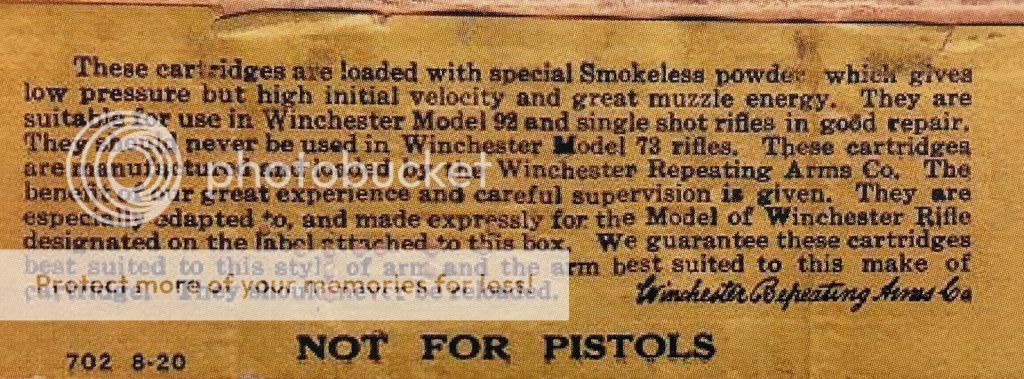Savvy_Jack
New member
Winchester 44WCF Box Label Color Codes
I tried to gather some basic cartridge box color coding information and dates for those that may have an interest. One would think that there would be a sense of security in not getting the wrong ammo, especially the more powerful High Velocity loads. Certainly there would be no confusion right?
Label Color/Powder Type/Projectile Type
Green/Black Powder/Lead
Red/Smokeless/Lead or Soft Point
Orange/Smokeless/Full Patch
Yellow/Smokeless/Soft Point…High Velocity
Lavender/Pink/Smokeless/Full Patch…High Velocity
Grey/Grey-Green/Lesmoke/Any
Tan, red print/ Smokeless/Any Bank or Proof Loadings
Tan, black print/Black Powder/Primed Empties. Blank, Military, Special Order loadings
During this time frame the cartridge box was never designated "44WCF" The earliest 1st boxes were designated 44/100 just like the 44 Henry boxes. Second box designs only showed "Winchester Model 1873" on the bullet photo on the box. Others were shown as simply Winchester Rifles 73' and/or 92. No mention of the 44WCF designation.
No case headstamps from 1873-1884
1884 is when Winchester started headstamping their cases with WRACo. 44WCF
1873-1874, 1st Box Label..44/100 Winchester Repeating Rifle...Yellowish...excluded from color code (Milbank Primed [Copper Cases?])
1874-1876, 2nd Box "Green" Label...Winchester Model 1873 (top label wraps around right side)
1876-1877, Factory boxes were not sealed until the mid 1870's
1877-1880,
1880-1883, 3rd Box "Green" Label....44 Cal Winchester Rifle Model 1873 (No Headstamp)
1884-1890's, "Central Fire" (WCF Headstamp)
1890's- , "Central Fire" changed to "Center Fire"
1895, First Smokeless Load, red top label, green side labels, "Winchester Rifle Model 1873" on
top label with the 1892 added on the green side label.
1900-1903, Red Label (not high velocity loads) but does note "NOT FOR PISTOLS" on side label
example 1900-1903, Red Label "Winchester Rifle Model 1873"
example, Red Label "Winchester Rifle Models 1873 and 1892"
1906, Date Coding…specification/Labeling changes; File Codes…Label covering/loading
1890's-1906, Fancy WRACo logo
1906-1910, Red "W" side logo, example date 4-7
1907-1912, Silver "W" side logo
1903-1938, Winchester High Velocity Loads
example 1909, Lavender top label .44-40 Model 1892 Special
example 1920 side label on the 10-9 box (above) denotes NOT FOR PISTOLS
example Kxxxx code, 1930's Yellow label
1910-1912, Italicized "Winchester" marks typical, example date 2-12…Black Powder Hollow Point…
Trade Mark
example 1914, Sliver "W" replaced by white outlined "W" side logo
1912-1920, Trade Mark+"throughout the world"…example data 11-15
example 1919…Models '73" and '92" replacing 1873 and 1892 call-out
example 1920…shows other misc changes
example 1911..."Lesmoke" box
example 1912…Lesmoke "W" stamped on primers
example 1919…phased out half split box design
1920-1928, two-piece boxes
1928, New "Staynless" Primers and one-piece blue/white boxes
1939-1945, Blue/Yellow boxes...red trim
1946-1956, Red/Yellow box…
to be continued.....
I tried to gather some basic cartridge box color coding information and dates for those that may have an interest. One would think that there would be a sense of security in not getting the wrong ammo, especially the more powerful High Velocity loads. Certainly there would be no confusion right?
Label Color/Powder Type/Projectile Type
Green/Black Powder/Lead
Red/Smokeless/Lead or Soft Point
Orange/Smokeless/Full Patch
Yellow/Smokeless/Soft Point…High Velocity
Lavender/Pink/Smokeless/Full Patch…High Velocity
Grey/Grey-Green/Lesmoke/Any
Tan, red print/ Smokeless/Any Bank or Proof Loadings
Tan, black print/Black Powder/Primed Empties. Blank, Military, Special Order loadings
During this time frame the cartridge box was never designated "44WCF" The earliest 1st boxes were designated 44/100 just like the 44 Henry boxes. Second box designs only showed "Winchester Model 1873" on the bullet photo on the box. Others were shown as simply Winchester Rifles 73' and/or 92. No mention of the 44WCF designation.
No case headstamps from 1873-1884
1884 is when Winchester started headstamping their cases with WRACo. 44WCF
1873-1874, 1st Box Label..44/100 Winchester Repeating Rifle...Yellowish...excluded from color code (Milbank Primed [Copper Cases?])
1874-1876, 2nd Box "Green" Label...Winchester Model 1873 (top label wraps around right side)
1876-1877, Factory boxes were not sealed until the mid 1870's
1877-1880,
1880-1883, 3rd Box "Green" Label....44 Cal Winchester Rifle Model 1873 (No Headstamp)
1884-1890's, "Central Fire" (WCF Headstamp)
1890's- , "Central Fire" changed to "Center Fire"
1895, First Smokeless Load, red top label, green side labels, "Winchester Rifle Model 1873" on
top label with the 1892 added on the green side label.
1900-1903, Red Label (not high velocity loads) but does note "NOT FOR PISTOLS" on side label
example 1900-1903, Red Label "Winchester Rifle Model 1873"
example, Red Label "Winchester Rifle Models 1873 and 1892"
1906, Date Coding…specification/Labeling changes; File Codes…Label covering/loading
1890's-1906, Fancy WRACo logo
1906-1910, Red "W" side logo, example date 4-7
1907-1912, Silver "W" side logo
1903-1938, Winchester High Velocity Loads
example 1909, Lavender top label .44-40 Model 1892 Special
example 1920 side label on the 10-9 box (above) denotes NOT FOR PISTOLS
example Kxxxx code, 1930's Yellow label
1910-1912, Italicized "Winchester" marks typical, example date 2-12…Black Powder Hollow Point…
Trade Mark
example 1914, Sliver "W" replaced by white outlined "W" side logo
1912-1920, Trade Mark+"throughout the world"…example data 11-15
example 1919…Models '73" and '92" replacing 1873 and 1892 call-out
example 1920…shows other misc changes
example 1911..."Lesmoke" box
example 1912…Lesmoke "W" stamped on primers
example 1919…phased out half split box design
1920-1928, two-piece boxes
1928, New "Staynless" Primers and one-piece blue/white boxes
1939-1945, Blue/Yellow boxes...red trim
1946-1956, Red/Yellow box…
to be continued.....
Last edited:




